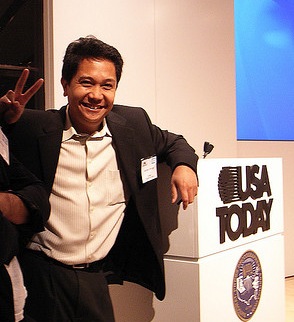Journalists who've hoarded skills ranging from coding to photography to design can start unpacking their toolboxes.
"Gone are the days of back-pack journalists," said Andrew DeVigal, a veteran of multimedia news, in an interview with IJNet. "When an individual tries to do everything, something suffers."
DeVigal's had years of experience working with and managing teams as The New York Times multimedia editor, creative director for interactive storytelling company Second Story and design director for The Chicago Tribune. He's currently the chair of Journalism Innovation and Civic Engagement at the University of Oregon; a co-founder of A Fourth Act, a collective that builds community and engagement around stories; and curates the site Interactive Narratives, a compendium of the best visual storytelling online.
IJNet chatted with DeVigal about his thoughts on multimedia journalism, how legacy news outlets are turning the digital tide and the importance of team-building for interactive projects.
IJNet: Since most interactive news features use varying types of media, do you feel that collaboration between specialists of different media platforms is important?
Andrew DeVigal: Definitely. I’m a huge believer in collaboration as it elevates the expertise of individuals to feed the collective whole...Don’t get me wrong, certain people can probably do one or two, even perhaps, three things really well, but when you start adding the complexity of multiple media platforms, you’ll be wiser to collaborate with someone who can make the work better.
IJNet: Do you think that older, more established news organizations like The New York Times are effectively incorporating these platforms, and if not what changes do you think they need to make in the future?
AD: Legacy brands like The Times are absolutely effectively incorporating new tech platforms to distribute their stories and content. And it’s to the startup’s interest to engage these legacy brands to use their tools as it will harness the millions of built-in audience that already exist.
And I would say that it’s smart to tread carefully and not to simply jump into the next shiny object. There are real costs and resources in integrating a corporate brand with new tech platforms wholeheartedly.
My recommendation in the past, as I do with my own personal brand, is to [make sure the original platform is secure] and slowly test the waters before opening up the full stream of engagement. One also needs to define success in such incorporation. Is it pageviews you’re trying to obtain by such collaboration or is it brand awareness into new markets?
 IJNet: Can you give any examples of a “good” and “bad” interactive news report? What makes a “good” interactive news feature?
IJNet: Can you give any examples of a “good” and “bad” interactive news report? What makes a “good” interactive news feature?
AD: I tend not to cite specific examples as it’s not helpful to call projects out in such a public forum. However, I think we need a clear definition of what “interactive” is. In my mind, interactive in journalism empowers a user to be more engaged with the content insomuch that they control the experience or have the ability to choose a piece of story or info on their own if they wanted to go through a different path or choose to go a little deeper.
What makes great storytelling is when a narrative has layers you reveal as a story is told. Adding interactivity to it basically embraces the idea of allowing users to peel those layers based on their desires and inclination to be informed.
IJNet: Is there any advice you’d like to give to journalists who are looking to enter this field?
AD: I think you touched on something in your first question: collaboration and team-building. I don’t think people recognize the importance of teams in this new connected world. It’s no surprise that an element of team-building is identifying the talent gaps in your organization (or team) to achieve your objectives. Identifying, hiring and putting together an interdisciplinary team with diverse backgrounds will prepare the organization in taking on existing challenges as well as anticipating ones in an innovative environment.
Collaboration happens when each member of the team respects the individual’s area of expertise. Included in this collaboration is the need for each member to respect the vision of the singular lead for the project. Especially in projects that may require various perspectives from different disciplines, a leader has to cultivate that environment of trust and a singular vision.
Gabriel Guzman is covering the latest in journalism innovation worldwide as a class assignment for "Global Media: Innovation and Economic Development," a course offered by Columbia University's School of International and Public Affairs.
Main image CC-licensed on Flickr via Cory M. Grenier. Second image CC-licensed on Flickr via keithwj.

